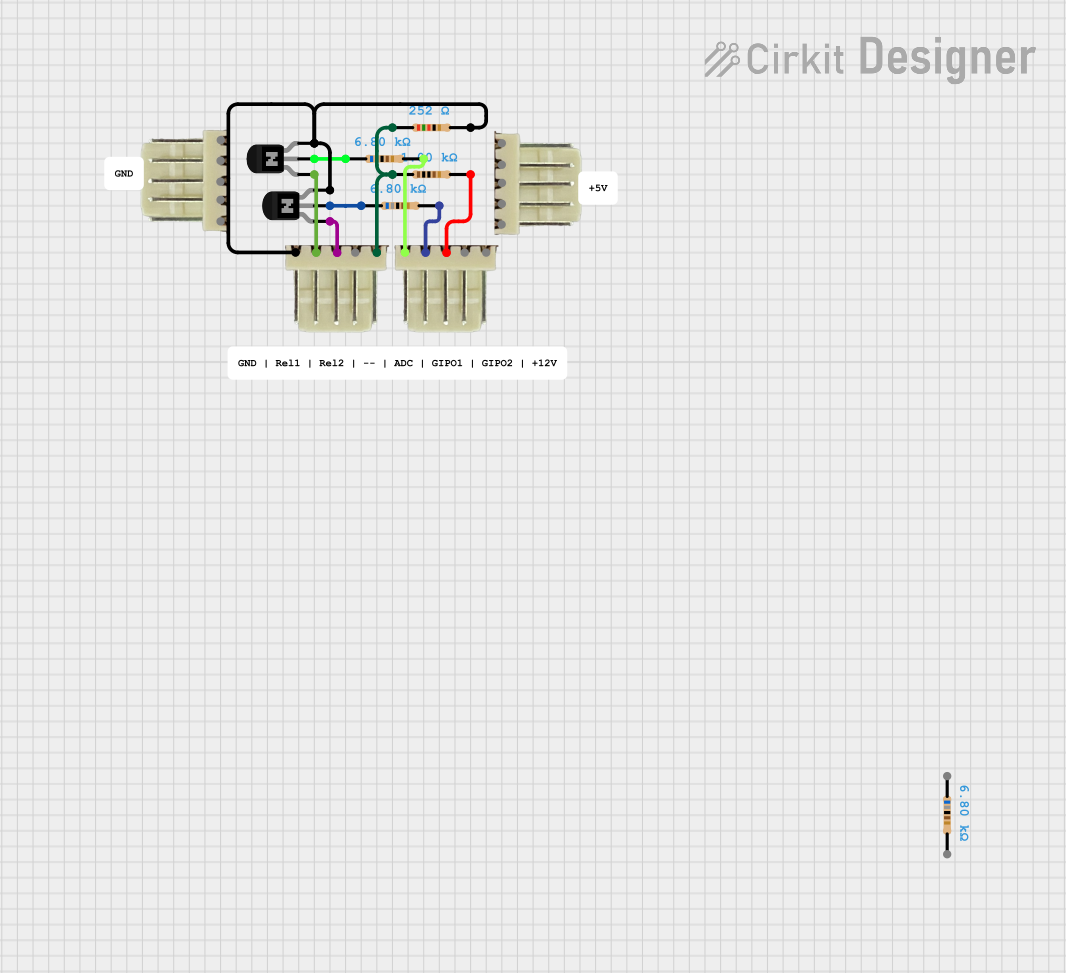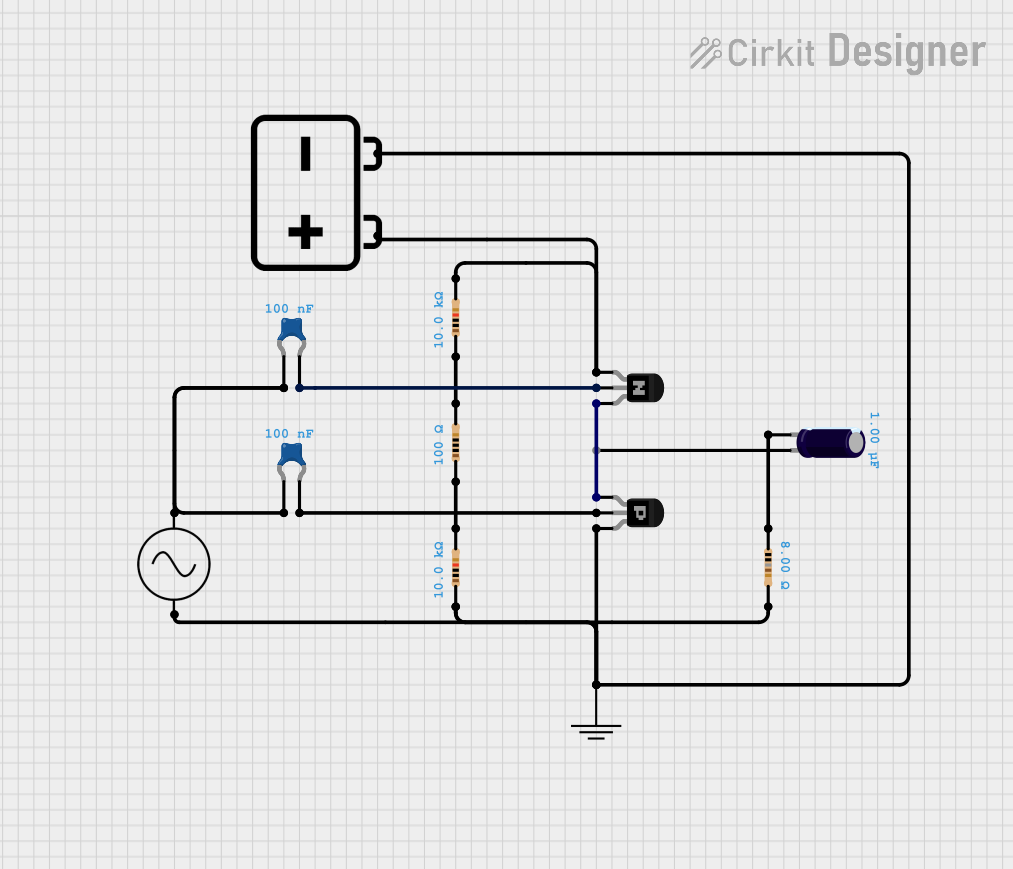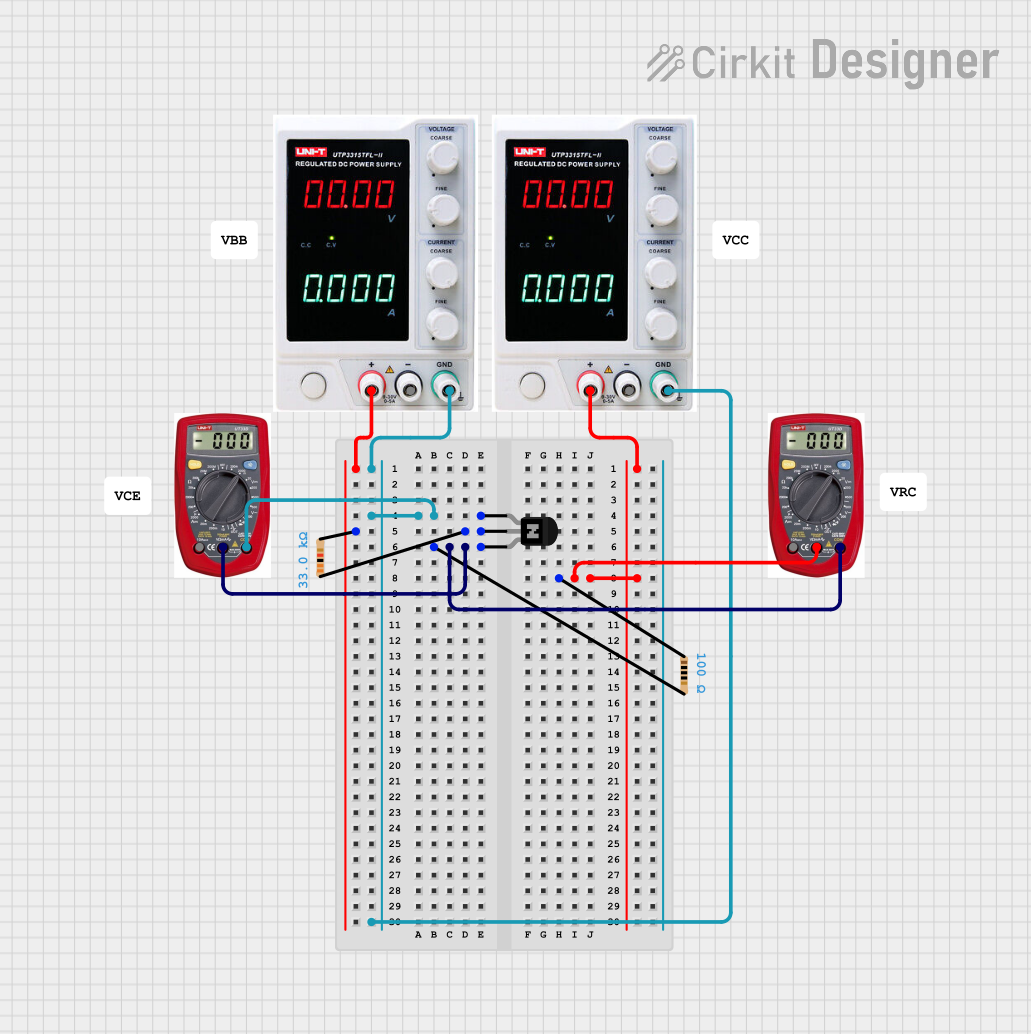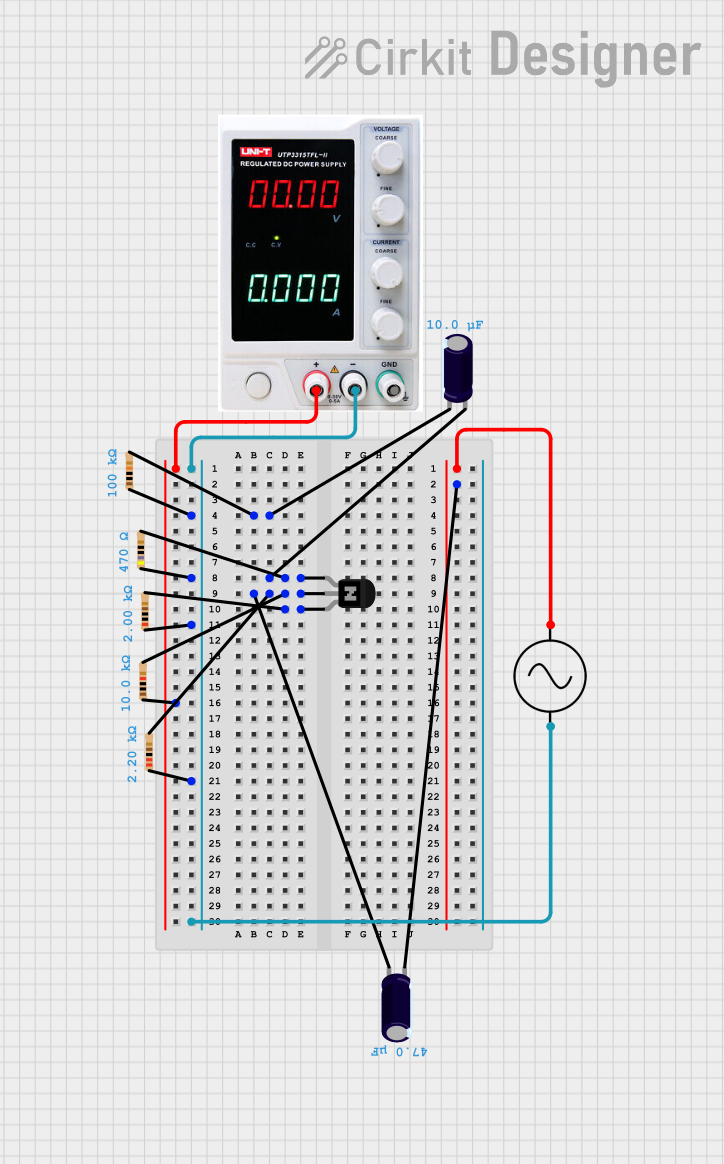
Cirkit Designer
Your all-in-one circuit design IDE
Home /
Component Documentation
How to Use Transistor generic: Examples, Pinouts, and Specs

 Design with Transistor generic in Cirkit Designer
Design with Transistor generic in Cirkit DesignerIntroduction
A transistor is a semiconductor device used to amplify or switch electronic signals and electrical power. It is a fundamental building block of modern electronic devices and is used in a wide range of applications, from simple amplifiers to complex integrated circuits.
Explore Projects Built with Transistor generic
NPN Transistor-Based Signal Interface with Relimate Connectors

This circuit appears to be a simple transistor-based switching circuit with multiple NPN transistors and resistors, interfaced through relimate connectors. The transistors are likely used to control the flow of current through various parts of the circuit, possibly for switching or amplification purposes, with the relimate connectors providing external connections for power and signal lines.
 Open Project in Cirkit Designer
Open Project in Cirkit DesignerTransistor-Based Signal Modulation Circuit with AC/DC Power Integration

This circuit appears to be a transistor-based switching or amplification system powered by a 12v battery, with an AC supply possibly for signal input or additional power. It includes filtering through ceramic capacitors and uses resistors for biasing the transistors. The presence of both PNP and NPN transistors suggests a push-pull configuration or a form of signal modulation.
 Open Project in Cirkit Designer
Open Project in Cirkit DesignerNPN Transistor-Based Voltage Measurement Circuit with Dual Power Supplies

This circuit is a simple NPN transistor switch configuration powered by two power supplies. It includes resistors to limit current and multimeters to measure voltage and current at various points in the circuit.
 Open Project in Cirkit Designer
Open Project in Cirkit DesignerNPN Transistor-Based Signal Amplifier with Power Supply and Capacitors

This circuit appears to be a basic transistor amplifier with a power supply, resistors, and capacitors. The NPN transistor is configured with various resistors and capacitors to control the biasing and signal amplification, while the AC supply and electrolytic capacitors are used for coupling and filtering purposes.
 Open Project in Cirkit Designer
Open Project in Cirkit DesignerExplore Projects Built with Transistor generic

NPN Transistor-Based Signal Interface with Relimate Connectors
This circuit appears to be a simple transistor-based switching circuit with multiple NPN transistors and resistors, interfaced through relimate connectors. The transistors are likely used to control the flow of current through various parts of the circuit, possibly for switching or amplification purposes, with the relimate connectors providing external connections for power and signal lines.
 Open Project in Cirkit Designer
Open Project in Cirkit Designer
Transistor-Based Signal Modulation Circuit with AC/DC Power Integration
This circuit appears to be a transistor-based switching or amplification system powered by a 12v battery, with an AC supply possibly for signal input or additional power. It includes filtering through ceramic capacitors and uses resistors for biasing the transistors. The presence of both PNP and NPN transistors suggests a push-pull configuration or a form of signal modulation.
 Open Project in Cirkit Designer
Open Project in Cirkit Designer
NPN Transistor-Based Voltage Measurement Circuit with Dual Power Supplies
This circuit is a simple NPN transistor switch configuration powered by two power supplies. It includes resistors to limit current and multimeters to measure voltage and current at various points in the circuit.
 Open Project in Cirkit Designer
Open Project in Cirkit Designer
NPN Transistor-Based Signal Amplifier with Power Supply and Capacitors
This circuit appears to be a basic transistor amplifier with a power supply, resistors, and capacitors. The NPN transistor is configured with various resistors and capacitors to control the biasing and signal amplification, while the AC supply and electrolytic capacitors are used for coupling and filtering purposes.
 Open Project in Cirkit Designer
Open Project in Cirkit DesignerCommon Applications and Use Cases
- Amplification: Used in audio amplifiers, radio frequency amplifiers, and signal processing.
- Switching: Employed in digital circuits, power regulation, and motor control.
- Oscillators: Utilized in signal generation and timing circuits.
- Voltage Regulation: Used in power supply circuits to maintain a stable output voltage.
Technical Specifications
Key Technical Details
| Parameter | Value |
|---|---|
| Type | NPN or PNP |
| Maximum Voltage | Varies (e.g., 40V, 60V, 100V) |
| Maximum Current | Varies (e.g., 100mA, 1A, 10A) |
| Power Rating | Varies (e.g., 500mW, 1W, 10W) |
| Gain (hFE) | Varies (e.g., 100, 200, 300) |
Pin Configuration and Descriptions
| Pin Number | Pin Name | Description |
|---|---|---|
| 1 | Emitter | The terminal through which current leaves the transistor. |
| 2 | Base | The terminal that controls the transistor's operation. |
| 3 | Collector | The terminal through which current enters the transistor. |
Usage Instructions
How to Use the Transistor in a Circuit
- Identify the Type: Determine whether the transistor is NPN or PNP.
- Connect the Emitter: For NPN, connect the emitter to ground. For PNP, connect the emitter to the positive supply.
- Connect the Collector: For NPN, connect the collector to the load and then to the positive supply. For PNP, connect the collector to the load and then to ground.
- Control the Base: Apply a small current to the base to control the larger current flowing between the collector and emitter.
Important Considerations and Best Practices
- Biasing: Ensure proper biasing of the base-emitter junction to operate the transistor in the desired region (cutoff, active, or saturation).
- Heat Dissipation: Use appropriate heat sinks if the transistor is expected to dissipate significant power.
- Current Limiting: Use resistors to limit the base and collector currents to prevent damage to the transistor.
- Voltage Ratings: Ensure that the voltage ratings of the transistor are not exceeded to avoid breakdown.
Example Circuit with Arduino UNO
Here is an example of using an NPN transistor to control an LED with an Arduino UNO:
// Define the pin connected to the base of the transistor
const int transistorBasePin = 9;
// Define the pin connected to the LED
const int ledPin = 13;
void setup() {
// Set the transistor base pin as an output
pinMode(transistorBasePin, OUTPUT);
// Set the LED pin as an output
pinMode(ledPin, OUTPUT);
}
void loop() {
// Turn on the transistor by setting the base pin high
digitalWrite(transistorBasePin, HIGH);
// Turn on the LED
digitalWrite(ledPin, HIGH);
// Wait for 1 second
delay(1000);
// Turn off the transistor by setting the base pin low
digitalWrite(transistorBasePin, LOW);
// Turn off the LED
digitalWrite(ledPin, LOW);
// Wait for 1 second
delay(1000);
}
Troubleshooting and FAQs
Common Issues Users Might Face
Transistor Not Switching:
- Cause: Insufficient base current.
- Solution: Increase the base current by reducing the base resistor value.
Transistor Overheating:
- Cause: Excessive current or inadequate heat dissipation.
- Solution: Use a heat sink or reduce the load current.
No Amplification:
- Cause: Incorrect biasing.
- Solution: Check and adjust the biasing resistors to ensure proper operation.
Solutions and Tips for Troubleshooting
- Check Connections: Ensure all connections are secure and correct according to the circuit diagram.
- Measure Voltages: Use a multimeter to measure voltages at the transistor terminals to verify proper operation.
- Component Ratings: Verify that the transistor's voltage and current ratings are suitable for the application.
By following this documentation, users should be able to effectively utilize a generic transistor in various electronic circuits, ensuring proper operation and troubleshooting common issues.